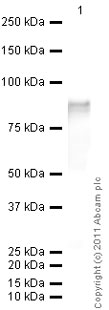Recombinant Human CLEC4E/Mincel
| Product name: | Recombinant Human CLEC4E/Mincel |
| Source: | |
| Purity: | Greater than 95% as determined by reducing SDS-PAGE. |
| Buffer Formulation: | Lyophilized from a 0.2 μm filtered solution of 20mM PB, 150mM NaCl, pH 7.4. |
| Applications: | Applications:SDS-PAGE; WB; ELISA; IP. |
| Storage: | Avoid repeated freeze/thaw cycles. Store at 2-8 oC for one month. Aliquot and store at -80 oC for 12 months. |
| UOM: | 100ug/50ug/200ug/1mg/1g |
| Source | Human Cells |
| Description | Recombinant Human CLEC4E is produced by our Mammalian expression system and the target gene encoding Arg41-Leu219 is expressed with a 6His tag at the C-terminus. |
| Names | C-Type Lectin Domain Family 4 Member E, C-Type Lectin Superfamily Member 9, Macrophage-Inducible C-Type Lectin, CLEC4E, CLECSF9, MINCLE |
| Accession # | Q9ULY5 |
| Formulation | Lyophilized from a 0.2 μm filtered solution of 20mM PB, 150mM NaCl, pH 7.4. |
| Shipping |
The product is shipped at ambient temperature. |
| Reconstitution |
Always centrifuge tubes before opening. Do not mix by vortex or pipetting. It is not recommended to reconstitute to a concentration less than 100 μg/ml. Dissolve the lyophilized protein in ddH2O. Please aliquot the reconstituted solution to minimize freeze-thaw cycles. |
| Storage |
Lyophilized protein should be stored at < -20°C, though stable at room temperature for 3 weeks. Reconstituted protein solution can be stored at 4-7°C for 2-7 days. Aliquots of reconstituted samples are stable at < -20°C for 3 months. |
| Purity |
Greater than 95% as determined by reducing SDS-PAGE. |
| Endotoxin | Less than 0.1 ng/µg (1 IEU/µg) as determined by LAL test. |
| Amino Acid Sequence |
RCVVTFRIFQTCDEKKFQLPENFTELSCYNYGSGSVKNCCPLNWEYFQSSCYFFSTDTISWALSL KNCSAMGAHLVVINSQEEQEFLSYKKPKMREFFIGLSDQVVEGQWQWVDGTPLTKSLSFWDVGEP NNIATLEDCATMRDSSNPRQNWNDVTCFLNYFRICEMVGINPLNKGKSLVDHHHHHH
|
| Background | C-Type Lectin Domain Family 4 Member E (CLEC4E) is a 219 amino acid single-pass type II membrane protein that contains one C-type Lectin domain. It is expressed in monocytes, CLEC4E functions as a downstream target of C/EBP β and is thought to play a role in the inflammatory response, possibly via transcriptional control of C/EBP β. CLEC4E may play a role in the response to inflammatory stimuli in peritoneal macrophages and may be involved in immune surveillance processes under transcriptional control of CEBPB. Human CLEC4E shares 67% sequence identity with its mouse counterpart, suggesting a similar function between species. CLEC-4E exists as multiple alternatively spliced isoforms that are encoded by a gene which maps to a natural killer gene complex region on human chromosome 12. |














